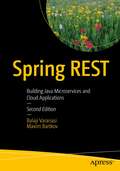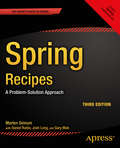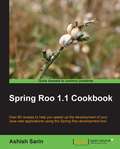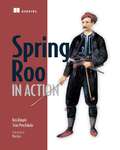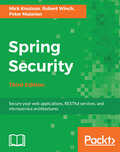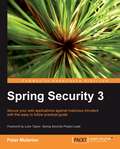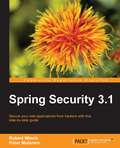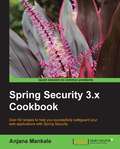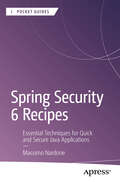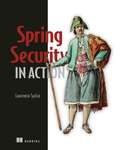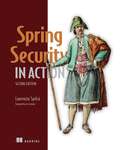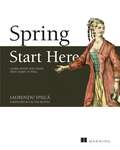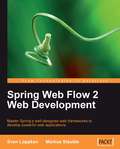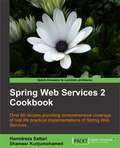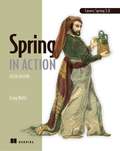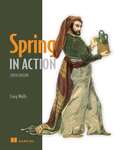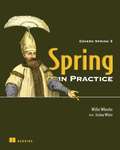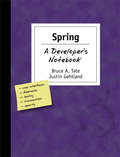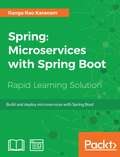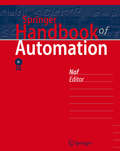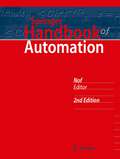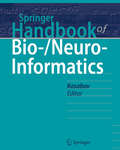- Table View
- List View
Spring REST
by Balaji Varanasi Sudha BelidaLearn how to build clients that consume REST services. Discover Spring Boot, Spring MVC, Spring Data JPA, and Spring Security and the role they play in simplifying REST application development. Finally, see how to use the Spring MVC test framework to unit test and integration test your REST API. Spring REST is a practical guide for designing and developing RESTful APIs using the Spring Framework. This book walks you through the process of designing and building a REST application while taking a deep dive into design principles and best practices for versioning, security, documentation, error handling, paging, and sorting. After reading this book, you will come away with all the skills to build sophisticated REST applications using Spring technologies. What you'll learn How to build REST applications with Spring technologies How to identify REST resources and design their representations How to version REST services How to document REST services using Swagger How to handle errors and communicate meaningful messages How to secure REST services using Basic Auth and OAuth 2. 0 How to handle large data sets using pagination How to build REST clients using RestTemplate How to test REST services using the Spring MVC test framework Who this book is for This book is for enterprise and web developers using Java and Spring and want to build REST applications. The book requires a basic knowledge of Java, Spring and the web, but no prior exposure to REST. Table of Contents 1. Introduction to REST 2. Spring MVC Primer 3. RESTful Spring 4. Beginning the QuickPoll Application 5. Error Handling 6. Documenting REST Services 7. Versioning, Paging, and Sorting 8. Security 9. Clients and Testing 10. HATEOAS Appendix: Installing cURL on Windows
Spring REST: Building Java Microservices and Cloud Applications
by Balaji Varanasi Maxim BartkovDesign and develop Java-based RESTful APIs using the latest versions of the Spring MVC and Spring Boot frameworks. This book walks you through the process of designing and building a REST application while delving into design principles and best practices for versioning, security, documentation, error handling, paging, and sorting. Spring REST provides a brief introduction to REST, HTTP, and web infrastructure. You will learn about several Spring projects such as Spring Boot, Spring MVC, Spring Data JPA, and Spring Security, and the role they play in simplifying REST application development. You will learn how to build clients that consume REST services. Finally, you will learn how to use the Spring MVC test framework to unit test and integration test your REST API. After reading this book, you will come away with all the skills to build sophisticated REST applications using Spring technologies. What You Will LearnBuild Java-based microservices, native cloud, or any applications using Spring RESTEmploy Spring MVC and RESTful SpringBuild a QuickPoll application exampleDocument REST services, as well as versioning, paging, and sortingTest, handle errors and secure your application Who This Book Is For Intermediate Java programmers with at least some prior experience with Spring and web/cloud application development.
Spring Recipes
by Josh Long Gary Mak Marten Deinum Daniel RubioThe Spring framework is growing. It has always been about choice. Java EE focused on a few technologies, largely to the detriment of alternative, better solutions. When the Spring framework debuted, few would have agreed that Java EE represented the best-in-breed architectures of the day. Spring debuted to great fanfare, because it sought to simplify Java EE. Each release since marks the introduction of new features designed to both simplify and enable solutions. With version 2. 0 and later, the Spring framework started targeting multiple platforms. The framework provided services on top of existing platforms, as always, but was decoupled from the underlying platform wherever possible. Java EE is a still a major reference point, but it's not the only target. OSGi (a promising technology for modular architectures) has been a big part of the SpringSource strategy here. Additionally, the Spring framework runs on Google App Engine. With the introduction of annotation-centric frameworks and XML schemas, SpringSource has built frameworks that effectively model the domain of a specific problem, in effect creating domain-specific languages (DSLs). Frameworks built on top of the Spring framework have emerged supporting application integration, batch processing, Flex and Flash integration, GWT, OSGi, and much more.
Spring Roo 1.1 Cookbook
by Ashish SarinThis is a cookbook full of recipes with the essential code explained clearly and comprehensively. The recipes are organized so well that you will have no problems in using this cookbook as a reference too. Spring Roo 1.1 Cookbook is for developers new to the Spring Roo tool but with experience developing applications using Spring framework, AspectJ, JPA, GWT, and technologies/frameworks supported by Spring Roo. If you are new to the Spring framework, then it is recommended to refer to a text covering Spring, before reading this Cookbook.
Spring Roo in Action
by Ken Rimple Srini PenchikalaSummarySpring Roo in Action is a unique book that teaches you how to code Java in Roo, with a particular focus on Spring-based applications. Through hands-on examples, you'll learn how Roo creates well-formed application structures and supports best practices and tools. Plus, you'll get a quick-and-dirty guide to setting up Roo effectively in your environment.About the TechnologyRoo is a lightweight Java console shell that simplifies compile-time tasks. It improves productivity by enforcing correct coding practices and patterns and integrates with mainstream Java technologies, including ActiveMQ, GWT, JPA, and OSGi. And, when you finish coding, it gets out of the way so there's no runtime impact.About the BookSpring Roo in Action teaches you to code Java more efficiently using Roo. With the help of many examples, it shows you how to build application components from the database layer to the user interface. The book takes a test-first approach and points out how Roo can help automate many of the mundane details of coding Java apps. Along the way, you'll address important topics like security, messaging, and cloud computing.This book is for Java developers who want to get more productive by using Roo. Purchase of the print book comes with an offer of a free PDF, ePub, and Kindle eBook from Manning. Also available is all code from the book. What's InsideLearn Roo from the ground upIntegrate with existing projectsCreate custom add-onsUse Roo with Spring======================================================Table of ContentsPART 1 STARTING SPRING APPS RAPIDLY WITH ROOWhat is Spring Roo?Getting started with RooPART 2 DATABASES AND ENTITIESDatabase persistence with entitiesRelationships, JPA, and advanced persistencePART 3 WEB DEVELOPMENTRapid web applications with RooAdvanced web applicationsRIA and other web frameworksConfiguring securityPART 4 INTEGRATIONTesting your applicationEnterprise services—email and messagingRoo add-onsAdvanced add-ons and deploymentPART 5 ROO IN THE CLOUDCloud computingWorkflow applications using Spring Integration
Spring Security - Third Edition: Secure Your Web Applications, Restful Services, And Microservice Architectures
by Peter Mularien Robert Winch Mick KnutsonLearn how to secure your Java applications from hackers using Spring Security 4.2 About This Book • Architect solutions that leverage the full power of Spring Security while remaining loosely coupled. • Implement various scenarios such as supporting existing user stores, user sign up, authentication, and supporting AJAX requests, • Integrate with popular Microservice and Cloud services such as Zookeeper, Eureka, and Consul, along with advanced techniques, including OAuth, JSON Web Token's (JWS), Hashing, and encryption algorithms Who This Book Is For This book is intended for Java Web and/or RESTful webservice developers and assumes a basic understanding of creating Java 8, Java Web and/or RESTful webservice applications, XML, and the Spring Framework. You are not expected to have any previous experience with Spring Security. What You Will Learn • Understand common security vulnerabilities and how to resolve them • Learn to perform initial penetration testing to uncover common security vulnerabilities • Implement authentication and authorization • Learn to utilize existing corporate infrastructure such as LDAP, Active Directory, Kerberos, CAS, OpenID, and OAuth • Integrate with popular frameworks such as Spring, Spring-Boot, Spring-Data, JSF, Vaaden, jQuery, and AngularJS. • Gain deep understanding of the security challenges with RESTful webservices and microservice architectures • Integrate Spring with other security infrastructure components like LDAP, Apache Directory server and SAML In Detail Knowing that experienced hackers are itching to test your skills makes security one of the most difficult and high-pressured concerns of creating an application. The complexity of properly securing an application is compounded when you must also integrate this factor with existing code, new technologies, and other frameworks. Use this book to easily secure your Java application with the tried and trusted Spring Security framework, a powerful and highly customizable authentication and access-control framework. The book starts by integrating a variety of authentication mechanisms. It then demonstrates how to properly restrict access to your application. It also covers tips on integrating with some of the more popular web frameworks. An example of how Spring Security defends against session fixation, moves into concurrency control, and how you can utilize session management for administrative functions is also included. It concludes with advanced security scenarios for RESTful webservices and microservices, detailing the issues surrounding stateless authentication, and demonstrates a concise, step-by-step approach to solving those issues. And, by the end of the book, readers can rest assured that integrating version 4.2 of Spring Security will be a seamless endeavor from start to finish. Style and approach This practical step-by-step tutorial has plenty of example code coupled with the necessary screenshots and clear narration so that grasping content is made easier and quicker.
Spring Security 3
by Peter MularienThe book starts by teaching the basic fundamentals of Spring Security 3 such as setup and configuration. Later it looks at more advanced topics showing the reader how to solve complex real world security issues. This book is for Java developers who build web projects and applications. The book assumes basic familiarity with Java, XML and the Spring Framework. Newcomers to Spring Security will still be able to utilize all aspects of this book.
Spring Security 3.1
by Robert WinchThis practical step-by-step tutorial has plenty of example code coupled with the necessary screenshots and clear narration so that grasping content is made easier and quicker,This book is intended for Java web developers and assumes a basic understanding of creating Java web applications, XML, and the Spring Framework. You are not assumed to have any previous experience with Spring Security.
Spring Security 3.x Cookbook
by Anjana MankaleThis book follows a cookbook style exploring various security solutions provided by Spring Security for various vulnerabilities and threat scenarios that web applications may be exposed to at the authentication and session level layers.This book is for all Spring-based application developers as well as Java web developers who wish to implement robust security mechanisms into web application development using Spring Security.Readers are assumed to have a working knowledge of Java web application development, a basic understanding of the Spring framework, and some knowledge of the fundamentals of the Spring Security framework architecture. Working knowledge of other web frameworks such as Grails and so on would be an added advantage to exploit the whole breadth of recipes provided in this book, but this is not mandatory.
Spring Security 6 Recipes: Essential Techniques for Quick and Secure Java Applications (Apress Pocket Guides)
by Massimo NardoneEnsure robust web security for your Java applications in just a few days. This recipe-driven, practical pocketbook provides a straightforward guide to quickly developing and deploying secure enterprise applications using the Spring 6 Framework, Spring Boot 3, and the H2 database. The book is organized into problems and corresponding recipes, offering solutions for both small and large challenges. First, you will learn how to install all essential development tools, such as IntelliJ IDEA, JDK v17, and Maven. Then you will dive into recipes on using Spring Security 6 with JSP tags and Thymeleaf and integrating security features through Spring Boot 3 Initializr. Finally, you'll be equipped to build your own Spring Boot project using Spring Security, Spring Data JDBC, and the H2 database. This recipes guide is ideal for readers who want to get up and running with only the essential security features in a fraction of time. Its simplified approach offers immediate results for securing Java applications. What You Will Learn Set up and configure Spring Security 6 installation tools Explore the basics of integrating Spring Security 6 with JSP tags, Thymeleaf, and Spring Boot 3 Initializr Build and deploy a secure Spring Boot application using Spring Data JDBC and the H2 database Who This Book Is For Beginners in Spring Security 6, Boot 3 Initializr, and H2 DB, and assumes you have some basic web development and security experience. It is suitable for busy readers who are seeking a simple, focused approach for immediate results. For more comprehensive coverage, detailed explanations, and advanced topics, we recommend Pro Spring Security: Securing Spring Framework 6 and Boot 3-based Java Applications.
Spring Security Essentials
by Nanda NachimuthuA fast-paced guide for securing your Spring applications effectively with the Spring Security frameworkAbout This BookExplore various security concepts using real-time examples of the Spring Security frameworkLearn about the functionalities that implement industry standard authentication and authorization mechanisms to secure enterprise-level applicationsDesign and develop advanced Spring Security layers by following a step-by-step approachWho This Book Is ForIf you are a developer who is familiar with Spring and you are looking to explore its security features, then this book is for you. All beginners and experienced users will benefit from this book since it is explores both the theory and practical usage in detail.What You Will LearnSee industry standard security implementations in actionUnderstand the principles of security servers, concepts, installation, and integrationUse Spring Extensions for various security mechanismsGet to grips with the internals of the tools and servers involved in the security layerWork through practical projects and working programsCompare different security servers and techniquesUse the sample projects in practical, real-time applicationsGet further readings and guidance on advanced security mechanismsIn DetailSpring Security is a framework that focuses on providing both authentication and authorization to Java applications. Like all Spring projects, the real power of Spring Security is how easily it can be extended to meet custom requirements. The popularity of the Spring framework is increasing and the security package of Spring addresses vast mechanisms of Security in a rich way. Due to an increasing number of applications for various business needs, the integration of multiple applications is becoming inevitable. The standard security procedures available across multiple implementations in Spring will protect vulnerable applications that are open to larger public and private audiences.Spring Security Essentials focuses on the need to master the security layer, which is an area not often explored by a Spring developer.At the beginning, we'll introduce various industry standard security mechanisms and the practical ways to integrate with them. We will also teach you about some up-to-date use cases such as building a security layer for RESTful web services and applications.The IDEs used and security servers involved are briefly explained, including the steps to install them. Many sample projects are also provided to help you practice your newly developed skills. Step-by-step instructions will help you master the security layer integration with the Server, then implement the experience gained from this book in your own real-time application.Style and approachThis practical guide is packed with detailed explanations of the underlying concepts, as well as screenshots and working examples that guarantee hands-on learning.
Spring Security in Action
by Laurentiu SpilcaSpring Security in Action shows you how to prevent cross-site scripting and request forgery attacks before they do damage. You&’ll start with the basics, simulating password upgrades and adding multiple types of authorization. As your skills grow, you'll adapt Spring Security to new architectures and create advanced OAuth2 configurations. By the time you're done, you'll have a customized Spring Security configuration that protects against threats both common and extraordinary.Summary While creating secure applications is critically important, it can also be tedious and time-consuming to stitch together the required collection of tools. For Java developers, the powerful Spring Security framework makes it easy for you to bake security into your software from the very beginning. Filled with code samples and practical examples, Spring Security in Action teaches you how to secure your apps from the most common threats, ranging from injection attacks to lackluster monitoring. In it, you'll learn how to manage system users, configure secure endpoints, and use OAuth2 and OpenID Connect for authentication and authorization. Purchase of the print book includes a free eBook in PDF, Kindle, and ePub formats from Manning Publications. About the technology Security is non-negotiable. You rely on Spring applications to transmit data, verify credentials, and prevent attacks. Adopting "secure by design" principles will protect your network from data theft and unauthorized intrusions. About the book Spring Security in Action shows you how to prevent cross-site scripting and request forgery attacks before they do damage. You&’ll start with the basics, simulating password upgrades and adding multiple types of authorization. As your skills grow, you'll adapt Spring Security to new architectures and create advanced OAuth2 configurations. By the time you're done, you'll have a customized Spring Security configuration that protects against threats both common and extraordinary. What's inside Encoding passwords and authenticating users Securing endpoints Automating security testing Setting up a standalone authorization server About the reader For experienced Java and Spring developers. About the author Laurentiu Spilca is a dedicated development lead and trainer at Endava, with over ten years of Java experience. Table of Contents PART 1 - FIRST STEPS 1 Security Today 2 Hello Spring Security PART 2 - IMPLEMENTATION 3 Managing users 4 Dealing with passwords 5 Implementing authentication 6 Hands-on: A small secured web application 7 Configuring authorization: Restricting access 8 Configuring authorization: Applying restrictions 9 Implementing filters 10 Applying CSRF protection and CORS 11 Hands-on: A separation of responsibilities 12 How does OAuth 2 work? 13 OAuth 2: Implementing the authorization server 14 OAuth 2: Implementing the resource server 15 OAuth 2: Using JWT and cryptographic signatures 16 Global method security: Pre- and postauthorizations 17 Global method security: Pre- and postfiltering 18 Hands-on: An OAuth 2 application 19 Spring Security for reactive apps 20 Spring Security testing
Spring Security in Action, Second Edition (In Action)
by Laurentiu SpilcaDon't let security be an afterthought. Spring Security in Action, Second Edition is your vital companion to robust, secure applications that are protected right from the first line of code.Spring Security in Action, Second Edition is a revised version of the bestselling original, fully updated for Spring Boot 3 and Oauth2/OpenID Connect. In Spring Security in Action, Second Edition you will learn essential security skills including how to: Implement and customize authentication and authorization Set up all components of an OAuth2/OpenID Connect system Utilize CRSF and CORS configurations Secure Spring reactive applications Write tests for security configurations Whether you&’re a beginner or a pro, Spring Security in Action, Second Edition teaches you how to secure your Java applications from the ground up. Author Laurentiu Spilca distills his years of experience as a skilled Java and Spring developer into an indispensable guide to everything security—from authentication and authorization, to testing security configurations. This new edition covers the latest patterns for application-level security in Spring apps, demonstrating how Spring Security simplifies every step of the security process. Foreword by Joe Grandja. About the technology Spring Security makes it much, much easier to secure enterprise-scale Java applications. This powerful framework integrates with Spring apps end to end, with &“secure by design&” principles and ready-to-use features that help you implement robust authorization and authentication and protect against data theft and intrusions. And like everything else in the Spring ecosystem, it&’s free, open source, and backed by the awesome team at VMWare. About the book Spring Security in Action, Second Edition updates this bestselling guide to Spring Security to include deep coverage of OAuth2/OpenID Connect and security configuration using the new SecurityFilterChain. The crystal clear explanations and relevant examples, teach you how to build your own authorization server, configure secure endpoints, and prevent cross-site scripting and request forgery attacks. What's inside Custom authentication and authorization CRSF and CORS configurations Secure Spring reactive applications Write tests for security configurations About the reader For experienced Java and Spring developers. About the author Laurentiu Spilca is a skilled Java and Spring developer and an experienced technology instructor. He is also the author of Manning&’s Spring Start Here and Troubleshooting Java. Table of Contents PART 1 1 Security today 2 Hello, Spring Security PART 2 3 Managing users 4 Managing passwords 5 A web app&’s security begins with filters 6 Implementing authentications PART 3 7 Configuring endpoint-level authorization: Restricting access 8 Configuring endpoint-level authorization: Applying restrictions 9 Configuring CSRF protection 10 Configuring CORS 11 Implementing authorization at the method level 12 Implementing filtering at the method level PART 4 13 What are OAuth 2 and OpenID Connect? 14 Implementing an OAuth 2 authorization server 15 Implementing an OAuth 2 resource server 16 Implementing an OAuth 2 client PART 5 17 Implementing security in reactive applications PART 6 18 Testing security configurations
Spring Start Here: Learn what you need and learn it well
by Laurentiu SpilcaQuickly master the massive Spring ecosystem with this focused, hands-on guide that teaches you exactly what you need to know.In Spring Start Here, you will learn how to: Build web applications with Spring Manage application objects with Spring context Implement data persistence using data sources and transactions Implement data exchange between applications using REST services Utilize Spring Boot's convention-over-configuration approach Write unit and integration tests for apps implemented with Spring Minimize work when building any kind of app Persisting data in a Spring application using the latest approach Spring Start Here introduces you to Java development with Spring by concentrating on the core concepts you'll use in every application you build. You'll learn how to refactor an existing application to Spring, how to use Spring tools to make SQL database requests and REST calls, and how to secure your projects with Spring Security. There's always more to learn, and this book will make your next steps much easier. Purchase of the print book includes a free eBook in PDF, Kindle, and ePub formats from Manning Publications. About the technology For Java developers, Spring is the must-learn framework. This incredible development tool powers everything from small business ecommerce applications to enterprise-scale microservices. Mastering Spring is a long journey. Taking your first step is easy! Start here. About the book Spring Start Here teaches Java developers how to build applications using Spring framework. Informative graphics, relevant examples, and author Laurentiu Spilca's clear and lively writing make it easy to pick up the skills you need. You'll discover how to plan, write, and test applications. And by concentrating on the most important features, this no-nonsense book gives you a firm foundation for exploring Spring's rich ecosystem. What's inside Build web applications with Spring Minimize repetition and manual work Persisting data in a Spring application HTTP and REST-based web services Testing your Spring implementations About the reader For readers with beginning to intermediate Java skills. About the author Lauren?iu Spilca is a skilled Java and Spring developer and an experienced technology instructor. Table of Contents PART 1 FUNDAMENTALS 1 Spring in the real world 2 The Spring context: Defining beans 3 The Spring context: Wiring beans 4 The Spring context: Using abstractions 5 The Spring context: Bean scopes and life cycle 6 Using aspects with Spring AOP PART 2 IMPLEMENTATION 7 Understanding Spring Boot and Spring MVC 8 Implementing web apps with Spring Boot and Spring MVC 9 Using the Spring web scopes 10 Implementing REST services 11 Consuming REST endpoints 12 Using data sources in Spring apps 13 Using transactions in Spring apps 14 Implementing data persistence with Spring Data 15 Testing your Spring app
Spring Web Flow 2 Web Development
by Markus Stäuble Sven LüppkenThis book is a tutorial, with plenty of step-by-step instructions beginning with "getting started" material, followed by advanced coverage of this technology. The book has a practical approach towards the Spring MVC framework and is packed with practical examples and code. This book is targeted at Java web application developers who want to work on Spring Web Flow. This book is a must-read for those who desire to bridge the gap between the popular web framework and the popular application framework. It requires prior knowledge of the Spring framework, but no prior knowledge of Spring Web Flow.
Spring Web Services 2 Cookbook
by Shameer Kunjumohamed Hamidreza SattariThis is a cookbook full of recipes with the essential code explained clearly and comprehensively. Each chapter is neatly compartmentalized with focused recipes which are perfectly organized for easy reference and understanding. This book is for Java/J2EE developers. As the books covers a variety of topics in Web-Service development, it will serve as a reference guide to those already familiar with Web-Services. Beginners can also use this book to gain real-world experience of Web-Service development.
Spring in Action
by Craig WallsSummarySpring in Action, 5th Edition is the fully updated revision of Manning's bestselling Spring in Action. This new edition includes all Spring 5.0 updates, along with new examples on reactive programming, Spring WebFlux, and microservices. You'll also find the latest Spring best practices, including Spring Boot for application setup and configuration.Purchase of the print book includes a free eBook in PDF, Kindle, and ePub formats from Manning Publications.About the TechnologySpring Framework makes life easier for Java developers. New features in Spring 5 bring its productivity-focused approach to microservices, reactive development, and other modern application designs. With Spring Boot now fully integrated, you can start even complex projects with minimal configuration code. And the upgraded WebFlux framework supports reactive apps right out of the box!About the BookSpring in Action, 5th Edition guides you through Spring's core features, explained in Craig Walls' famously clear style. You'll roll up your sleeves and build a secure database-backed web app step by step. Along the way, you'll explore reactive programming, microservices, service discovery, RESTful APIs, deployment, and expert best practices. Whether you're just discovering Spring or leveling up to Spring 5.0, this Manning classic is your ticket!What's insideBuilding reactive applicationsSpring MVC for web apps and RESTful web servicesSecuring applications with Spring SecurityCovers Spring 5.0Over 100,000 copies sold!About the ReaderFor intermediate Java developers.About the AuthorCraig Walls is a principal software engineer at Pivotal, a popular author, an enthusiastic supporter of Spring Framework, and a frequent conference speaker.Table of ContentsPART 1 - FOUNDATIONAL SPRING Getting started with Spring Developing web applications Working with data Securing Spring Working with configuration properties PART 2 - INTEGRATED SPRINGCreating REST services Consuming REST services Sending messages asynchronously Integrating Spring PART 3 - REACTIVE SPRING Introducing Reactor Developing reactive APIs Persisting data reactivelyPART 4 CLOUD-NATIVE SPRINGDiscovering services Managing configuration Handling failure and latency PART 5 - DEPLOYED SPRING Working with Spring Boot Actuator Administering Spring Monitoring Spring with JMX Deploying Spring
Spring in Action, Sixth Edition
by Craig WallsIf you need to learn Spring, look no further than this widely beloved and comprehensive guide! Fully revised for Spring 5.3, and packed with interesting real-world examples to get your hands dirty with Spring.In Spring in Action, 6th Edition you will learn: Building reactive applications Relational and NoSQL databases Integrating via HTTP and REST-based services, and sand reactive RSocket services Reactive programming techniques Deploying applications to traditional servers and containers Securing applications with Spring Security Over the years, Spring in Action has helped tens of thousands of developers get a major productivity boost from Spring. This new edition of the classic bestseller covers all of the new features of Spring 5.3 and Spring Boot 2.4 along with examples of reactive programming, Spring Security for REST Services, and bringing reactivity to your databases. You'll also find the latest Spring best practices, including Spring Boot for application setup and configuration. About the technology Spring is required knowledge for Java developers! Why? Th is powerful framework eliminates a lot of the tedious configuration and repetitive coding tasks, making it easy to build enterprise-ready, production-quality software. The latest updates bring huge productivity boosts to microservices, reactive development, and other modern application designs. It&’s no wonder over half of all Java developers use Spring. About the book Spring in Action, Sixth Edition is a comprehensive guide to Spring&’s core features, all explained in Craig Walls&’ famously clear style. You&’ll put Spring into action as you build a complete database-backed web app step-by-step. This new edition covers both Spring fundamentals and new features such as reactive flows, Kubernetes integration, and RSocket. Whether you&’re new to Spring or leveling up to Spring 5.3, make this classic bestseller your bible! What's inside Relational and NoSQL databases Integrating via RSocket and REST-based services Reactive programming techniques Deploying applications to traditional servers and containers About the reader For beginning to intermediate Java developers. About the author Craig Walls is an engineer at VMware, a member of the Spring engineering team, a popular author, and a frequent conference speaker. Table of Contents PART 1 FOUNDATIONAL SPRING 1 Getting started with Spring 2 Developing web applications 3 Working with data 4 Working with nonrelational data 5 Securing Spring 6 Working with configuration properties PART 2 INTEGRATED SPRING 7 Creating REST services 8 Securing REST 9 Sending messages asynchronously 10 Integrating Spring PART 3 REACTIVE SPRING 11 Introducing Reactor 12 Developing reactive APIs 13 Persisting data reactively 14 Working with RSocket PART 4 DEPLOYED SPRING 15 Working with Spring Boot Actuator 16 Administering Spring 17 Monitoring Spring with JMX 18 Deploying Spring
Spring in Practice
by Joshua White Willie WheelerSummarySpring in Practice shows you how to tackle the challenges you face when you build Spring-based applications. The book empowers software developers to solve concrete business problems by mapping application-level issues to Spring-centric solutions. It diverges from other cookbooks because it presents the background you need to understand the domain in which a solution applies before it offers the specific steps to solve the problem. About this BookSpring in Practice covers 66 Spring development techniques and the practical issues you will encounter when using them. The book starts with three carefully crafted introductory chapters to get you up to speed on the fundamentals. And then, the core of the book takes you step-by-step through the important, practical techniques you will use no matter what type of application you're building. You'll hone your Spring skills with examples on user accounts, security, NoSQL data stores, and application integration. Along the way, you'll explore Spring-based approaches to domain-specific challenges like CRM, configuration management, and site reliability.What's InsideCovers Spring 3Successful outcomes with integration testingDozens of web app techniques using Spring MVCPractical examples and real-world contextHow to work effectively with dataEach technique highlights something new or interesting about Spring and focuses on that concept in detail. This book assumes you have a good foundation in Java and Java EE. Prior exposure to Spring Framework is helpful but not required.Purchase of the print book includes a free eBook in PDF, Kindle, and ePub formats from Manning Publications.About the AuthorsWillie Wheeler is a Principal Applications Engineer with 16 years of experience in Java/Java EE and Spring Framework. Joshua White is a Solutions Architect in the financial and health services industries. He has worked with Spring Framework since its inception in 2002.Table of ContentsIntroducing Spring: the dependency injection containerData persistence, ORM, and transactionsBuilding web applications with Spring Web MVCBasic web formsEnhancing Spring MVC applications with Web FlowAuthenticating usersAuthorizing user requestsCommunicating with users and customersCreating a rich-text comment engineIntegration testingBuilding a configuration management databaseBuilding an article-delivery engineEnterprise integrationCreating a Spring-based "site-up" framework
Spring: A Developer's Notebook
by Justin Gehtland Bruce A. TateSince development first began on Spring in 2003, there's been a constant buzz about it in Java development publications and corporate IT departments. The reason is clear: Spring is a lightweight Java framework in a world of complex heavyweight architectures that take forever to implement. Spring is like a breath of fresh air to overworked developers. In Spring, you can make an object secure, remote, or transactional, with a couple of lines of configuration instead of embedded code. The resulting application is simple and clean. In Spring, you can work less and go home early, because you can strip away a whole lot of the redundant code that you tend to see in most J2EE applications. You won't be nearly as burdened with meaningless detail. In Spring, you can change your mind without the consequences bleeding through your entire application. You'll adapt much more quickly than you ever could before. Spring: A Developer's Notebook offers a quick dive into the new Spring framework, designed to let you get hands-on as quickly as you like. If you don't want to bother with a lot of theory, this book is definitely for you. You'll work through one example after another. Along the way, you'll discover the energy and promise of the Spring framework. This practical guide features ten code-intensive labs that'll rapidly get you up to speed. You'll learn how to do the following, and more: install the Spring Framework set up the development environment use Spring with other open source Java tools such as Tomcat, Struts, and Hibernate master AOP and transactions utilize ORM solutions As with all titles in the Developer's Notebook series, this no-nonsense book skips all the boring prose and cuts right to the chase. It's an approach that forces you to get your hands dirty by working through one instructional example after another-examples that speak to you instead of at you.
Spring: Build and deploy microservices with Spring Boot
by Ranga Rao KaranamUnlock the power of Spring Boot to build and deploy production-ready microservicesKey Features Get to know the advanced features of Spring Boot in order to develop and monitor applications Use Spring cloud to deploy and manage microservices on the cloud Look at embedded servers and deploy a test application to a PaaS Cloud platform Embedded with assessments that will help you revise the concepts you have learned in this bookBook DescriptionMicroservices helps in decomposing applications into small services and move away from a single monolithic artifact. It helps in building systems that are scalable, flexible, and high resilient. Spring Boot helps in building REST-oriented, production-grade microservices. This book is a quick learning guide on how to build, monitor, and deploy microservices with Spring Boot. You'll be first familiarized with Spring Boot before delving into building microservices. You will learn how to document your microservice with the help of Spring REST docs and Swagger documentation. You will then learn how to secure your microservice with Spring Security and OAuth2. You will deploy your app using a self-contained HTTP server and also learn to monitor a microservice with the help of Spring Boot actuator. This book is ideal for Java developers who knows the basics of Spring programming and want to build microservices with Spring Boot.This book is embedded with useful assessments that will help you revise the concepts you have learned in this book.What you will learn Use Spring Initializr to create a basic spring project Build a basic microservice with Spring Boot Implement caching and exception handling Secure your microservice with Spring security and OAuth2 Deploy microservices using self-contained HTTP server Monitor your microservices with Spring Boot actuator Learn to develop more effectively with developer toolsWho this book is forThis book is aimed at Java developers who knows the basics of Spring programming and want to build microservices with Spring Boot.
Springer Handbook of Atomic, Molecular, and Optical Physics (Springer Handbooks)
by Gordon W. F. DrakeComprises a comprehensive reference source that unifies the entire fields of atomic molecular and optical (AMO) physics, assembling the principal ideas, techniques and results of the field. 92 chapters written by about 120 authors present the principal ideas, techniques and results of the field, together with a guide to the primary research literature (carefully edited to ensure a uniform coverage and style, with extensive cross-references). Along with a summary of key ideas, techniques, and results, many chapters offer diagrams of apparatus, graphs, and tables of data. From atomic spectroscopy to applications in comets, one finds contributions from over 100 authors, all leaders in their respective disciplines. Substantially updated and expanded since the original 1996 edition, it now contains several entirely new chapters covering current areas of great research interest that barely existed in 1996, such as Bose-Einstein condensation, quantum information, and cosmological variations of the fundamental constants. A fully-searchable CD- ROM version of the contents accompanies the handbook.
Springer Handbook of Automation
by Shimon Y. NofThis handbook incorporates new developments in automation. It also presents a widespread and well-structured conglomeration of new emerging application areas, such as medical systems and health, transportation, security and maintenance, service, construction and retail as well as production or logistics. The handbook is not only an ideal resource for automation experts but also for people new to this expanding field.
Springer Handbook of Automation (Springer Handbooks)
by Shimon Y. NofThis handbook incorporates new developments in automation. It also presents a widespread and well-structured conglomeration of new emerging application areas, such as medical systems and health, transportation, security and maintenance, service, construction and retail as well as production or logistics. The handbook is not only an ideal resource for automation experts but also for people new to this expanding field.
Springer Handbook of Bio-/Neuroinformatics
by Nikola KasabovThe Springer Handbook of Bio-/Neuro-Informatics is the first published book in one volume that explains together the basics and the state-of-the-art of two major science disciplines in their interaction and mutual relationship, namely: information sciences, bioinformatics and neuroinformatics. Bioinformatics is the area of science which is concerned with the information processes in biology and the development and applications of methods, tools and systems for storing and processing of biological information thus facilitating new knowledge discovery. Neuroinformatics is the area of science which is concerned with the information processes in biology and the development and applications of methods, tools and systems for storing and processing of biological information thus facilitating new knowledge discovery. The text contains 62 chapters organized in 12 parts, 6 of them covering topics from information science and bioinformatics, and 6 cover topics from information science and neuroinformatics. Each chapter consists of three main sections: introduction to the subject area, presentation of methods and advanced and future developments. The Springer Handbook of Bio-/Neuroinformatics can be used as both a textbook and as a reference for postgraduate study and advanced research in these areas. The target audience includes students, scientists, and practitioners from the areas of information, biological and neurosciences. With Forewords by Shun-ichi Amari of the Brain Science Institute, RIKEN, Saitama and Karlheinz Meier of the University of Heidelberg, Kirchhoff-Institute of Physics and Co-Director of the Human Brain Project.

